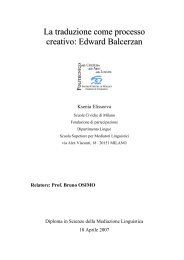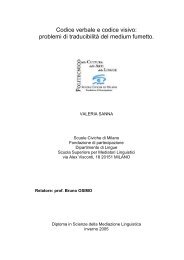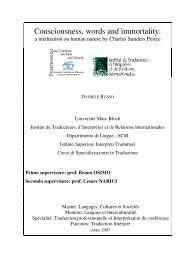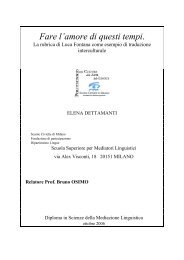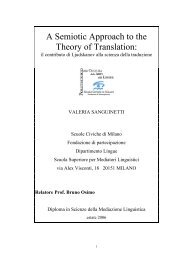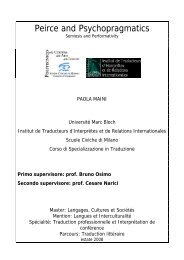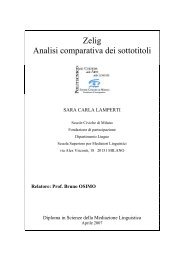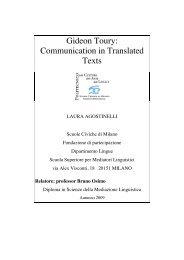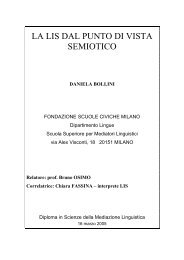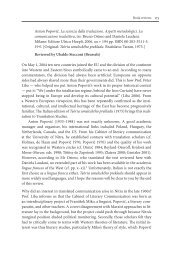Ksenia Elisseeva - Bruno Osimo, traduzioni, semiotica della ...
Ksenia Elisseeva - Bruno Osimo, traduzioni, semiotica della ...
Ksenia Elisseeva - Bruno Osimo, traduzioni, semiotica della ...
You also want an ePaper? Increase the reach of your titles
YUMPU automatically turns print PDFs into web optimized ePapers that Google loves.
y an “unraveled” line that retains the order of reading cards by groups and<br />
arranges the cards within each group in the order in which they should be read.<br />
Here, for example, is the transcription of a distribution, showing the card of the<br />
person whose fortune is being told (Q♥) and separating the groups within each<br />
temporal stratum with semicolons: Q♥, on her heart 7♥, 6♣; J♠, J♣, 10♥, A♦,<br />
what was K♠, A♥, 6♠; 7♣, 8♠; K♣, 9♦, 8♣, what is A♣, K♦; 9♥, K♥, what will be<br />
7♦, 10♦, 8♥; 6♥, J♦; Q♠, A♠, 7♠.<br />
Thus we can describe the plot of cartomancy conventionally and<br />
unambiguously, as with a game of chess, so that any reader can interpret its<br />
factual and emotional details. It is far more difficult to analyze the plots of works<br />
of art. A writer writes down a complete text by drawing upon the enormous<br />
reservoir of poetic vocabulary and saturates it with his ideas, emotions, and<br />
associations. The subsequent inclusion of the reader's subjectivity is wholly<br />
natural and analogous, though also more complex, to reading the distribution of<br />
the cards. Here “formulization” does not entail a simple ruling of a table into four<br />
suits by nine denominations, with inscription of the corresponding meanings of<br />
the cards, but rather an extremely difficult examination of how to elaborate the<br />
very principles of classification. Some principles will be needed by the<br />
researcher interested in plot syntax, plot grammar, and the dialectics of<br />
correlating plot elements; other principles will be needed by the historian of<br />
plots. Special scales must be created in each instance, and we literary scholars<br />
unfortunately do not yet possess a “Mendeleev's table” of plots. The necessity<br />
of creating such tables during the next few years hardly needs to be<br />
demonstrated 1 .<br />
1 True, there are still opponents of typology in literary scholarship in general who say that it<br />
destroys the specificity and unique individuality of artwork and writer. For some reason they do not protest<br />
against the classification, let us say, of characters in psychology or of types in anthropology. In those<br />
cases, systematics obviously does not suppress the distinctiveness of individuals. But why then is it<br />
contraindicated in literary scholarship?<br />
26



